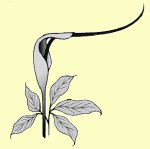
Arisaema dracontium
(green dragon, dragon root)
Home page
Articles
|

Seed exchange
serendipity
by George Erdman
Debby asked me to contribute something to the newsletter, preferably something having to do with growing from seed. Makes sense, since I show up every meeting with the leftover NARGS seeds, hawking my wares and badgering those who don't take at least a few. So I offer things I've had success with this year, beginning with two whose virtues I posted to
Alpine-L.
A thread on that discussion board on annuals for the rock garden led me to
Dicranostigma lactucoides, a member of the Papaver family. I set out seven plants in late April from a late January sowing. A creature who found them the first night set me back a tad. But I still managed to establish on a rock ledge a solid
2 foot x 2 foot clump of attractive hairy, parted leaves which raise up to some
15 inches a mass of four-petaled, butter-yellow flowers every morning. By late afternoon they all
disappear to be followed the next day by an equal display. Meanwhile the plants go about producing long, slender seed pods, much like those of
Eschscholzia californica, which I'll save for another go around next year.
On the next ledge above are three or four clumps of Campanula scheuchzeri, these from a
'96 sowing. The clumps, disappointing their second year, sent up this year multiple decumbent stems some
2 feet long which produced in the aggregate scores if not hundreds (all gardeners exaggerate) of typical light blue bells. In short, airy yellow backed by airy blue. It don't get much better than this.
I started last year in late May many of the left over seeds NARGS sent the chapter, among them
Francoa sonchifolia, Hypericum orientale, and Erodium manescasvi. They were pretty tender young things by the time winter came, and I suspected them not to be hardy in my hard Zone
5. So I carried them over under lights. Setting them out this spring, aphids and all, I got a mixed bag.
From the Francoa, tall spikes of undistinguished flowers I can live without, nothing like the pictures I've seen. But having learned that the genus is wildly variable, I take some comfort. From the
Hypericum, nice decumbent stems with small, sticky leaves, few flowers but a nice filler. I'll see if it overwinters. From the
Erodium, beautiful geranium-like flowers all summer long over nice foliage. I don't think it will overwinter, but I'll save seeds and begin anew. It's worth it.
Papaver anomalum and Papaver atlanticum, thoough the latter also has come as
Papaver miyobeanum, are plants I'll never be without. The former produces some white flowers the first year, endless white flowers the second year. The latter does the same with its pumpkin-orange display. Both are capable of lasting a third year, but yearly reseeding ensures yearly displays.
What can I say? I've many more plants to report on, but Debby told me not to abuse space. So I'll end with
Alyssum, a much maligned genus. I'm not talking about the big leaved, floppy plants that end up dead, I'm talking about prostrate, tiny leaved clumps that produce and produce, and when cut back, come back to go into the winter as healthy, evergreen, low, desirable mats. Try
Alyssum montanum or Alyssum wulfenianum. You'll rethink your prejudices.
Should Debby let me write again, I'll rave about Aethionema armenum,
Salvia jurisica, two Onosma that look like one, and more Silene than you can shake a stick at.
Web design and maintenance by Craig
Cramer, cdcramer@twcny.rr.com
|

